Abstract
Varicocele had been repeatedly implicated as a cause of infertility in selected men, although neither a causal relationship nor a mechanism has been documented. The purpose of this investigation was to create a varicocele model in animals and to study the subsequent alterations in testicular physiology. Secondary dilatation of the left internal spermatic vein was achieved either by partial ligation of the left renal vein in rats and dogs or by surgical destruction of the valve of the left testicular vein in a second group of dogs. 1 mo after partial ligation in the rats and 3 mo after partial ligation or valve destruction in the dogs, testicular blood flow was measured using Strontium 85 (SR-85)-labeled microspheres (15 +/- 1.1 micrometer). Intratesticular temperature was measured with a Bailey needle probe thermometer and biopsies were obtained for histologic sections. Mean testicular blood flow in milliliters per minute per 100 g was significantly greater in the partially ligated rats; right testis control 26 +/- 2, left testis control 24 +/- 2 compared to right testis experimental 35 +/- 3, left testis experimental 35 +/- 4 (p less than 0.02). Dogs undergoing either partial vein ligation or valve destruction showed similar increases in mean testicular blood flow; right testis control 8 +/- 1, left testis control 8 +/- 1 vs. right testis experimental 16 +/- 3, left testis experimental 18 +/- 4 (p less than 0.01). The mean difference between intratesticular and intraperitoneal temperature in control rats was significantly higher (4.02 +/- 0.25 degrees C right testis, 3.77 +/- 0.14 degrees C left testis), than rats who underwent partial vein ligation (right testis 2.14 +/- 0.09 degrees C, left testis 2.34 +/- 0.12 degrees C) (p less than 0.001). Control dogs also had a significantly higher mean difference between intratesticular and rectal temperatures; (right testis control 3.61 +/- 0.42 degrees C, left testis control 3.60 +/- 0.40 degrees C) than the partially ligated or valve destruction dogs (right testis 2.31 +/- 0.17 degrees C, left testis 2.67 +/- 0.32 degrees C) (p less than 0.05). In addition, histologic evaluation revealed abnormalities in spermatogenesis in some of the animals. Thus, venous dilatation secondary to partial vein ligation or testicular vein valve obliteration is followed by large bilateral increases in testicular blood flow in these two species. A consequence of this increased flow is an elevation in bilateral testicular temperature, which it is postulated, leads to impaired spermatogenesis in some of the animals. In selected men varicocele may impair spermatogenesis by a similar physiologic mechanism.
Full text
PDF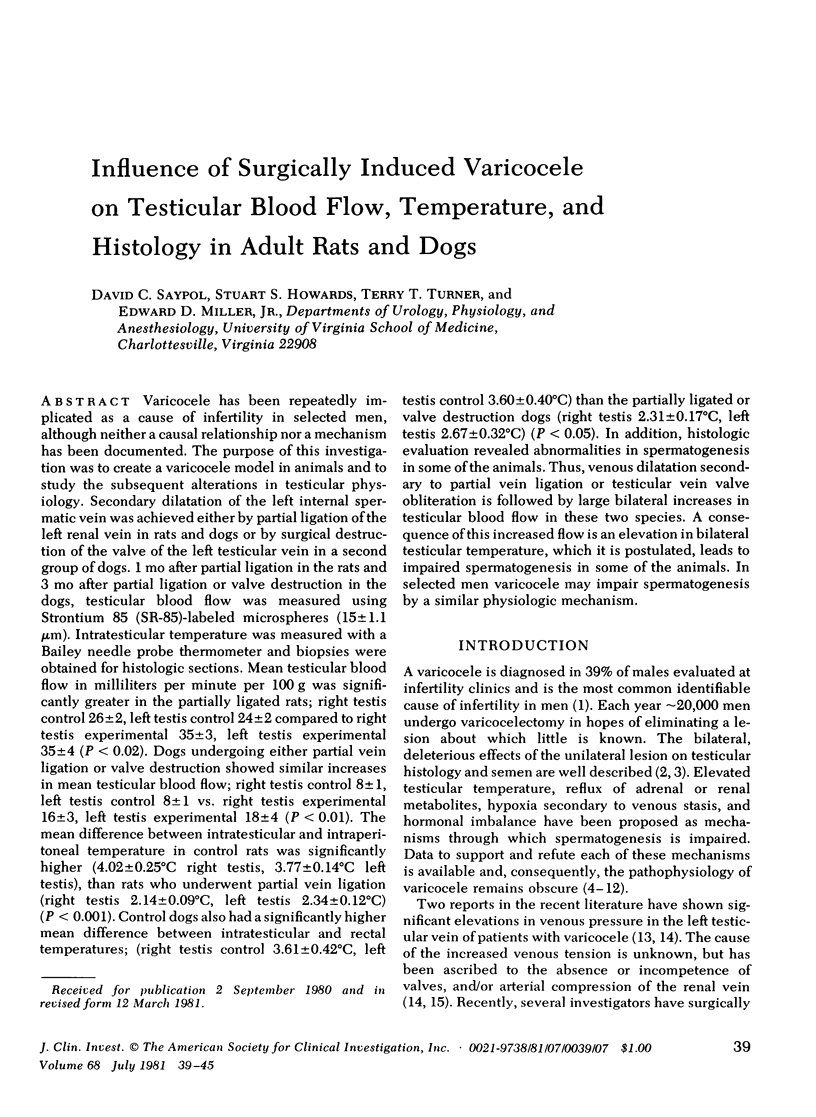
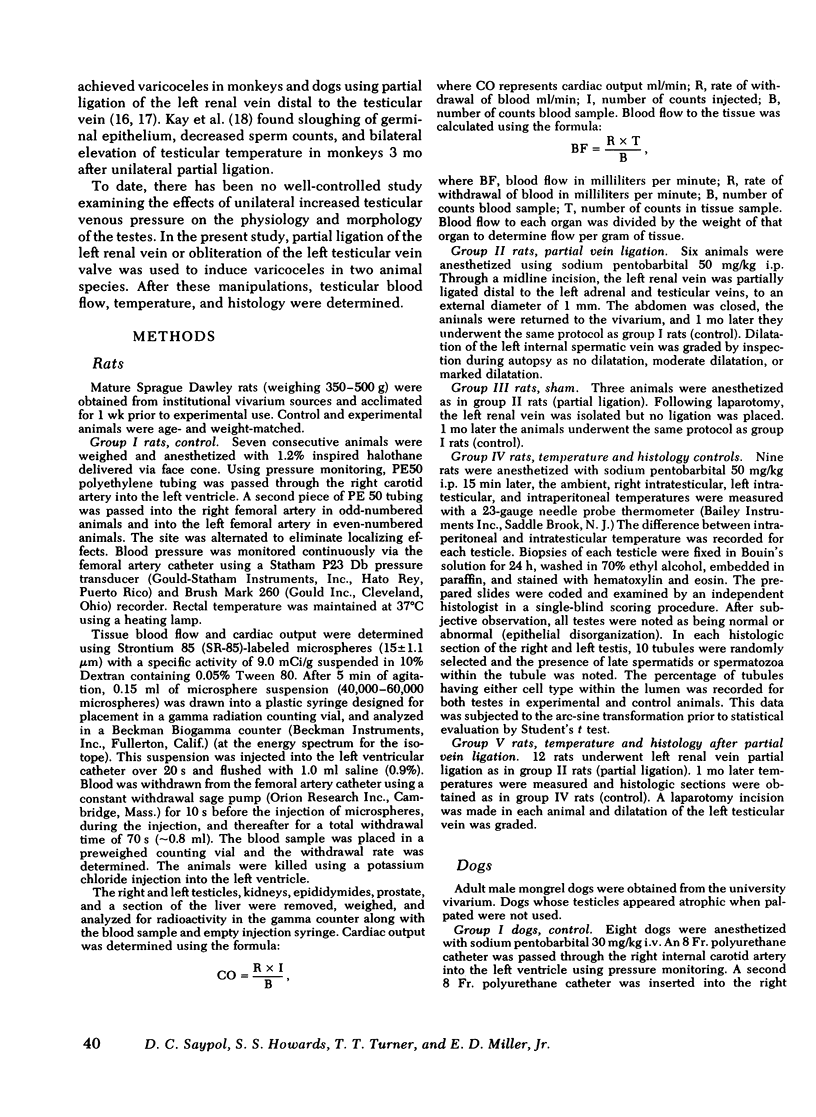
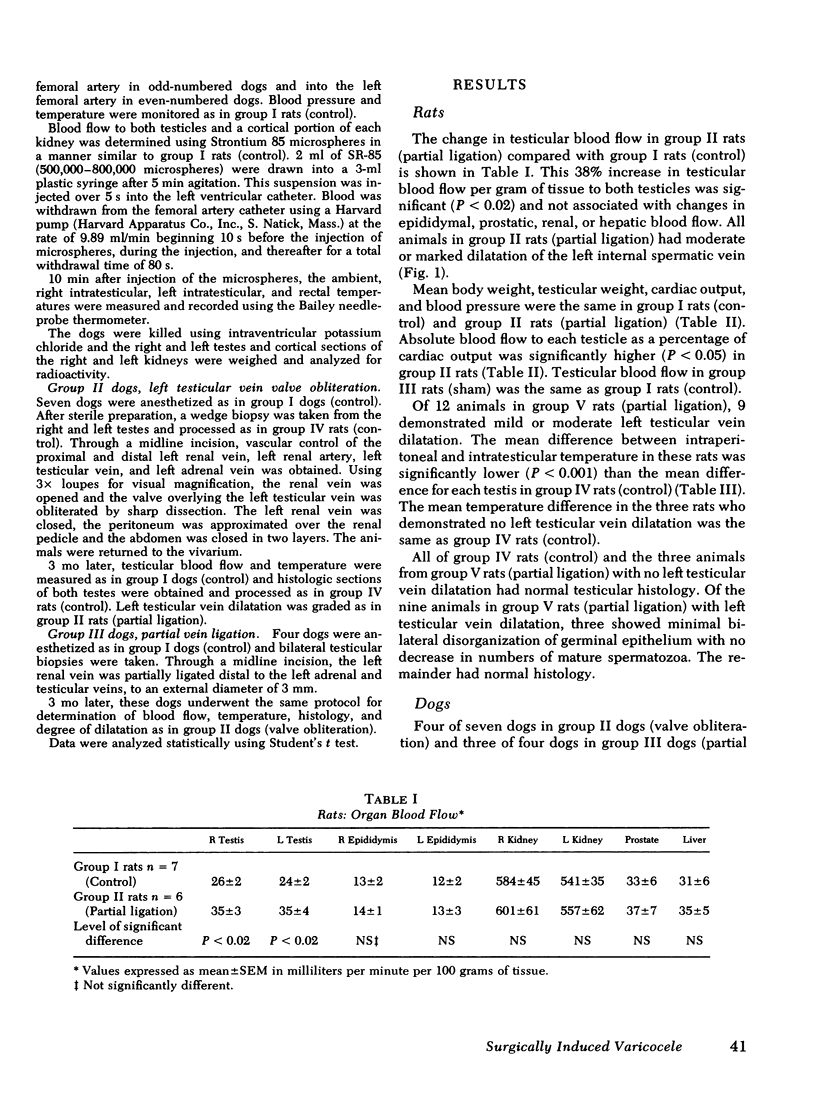

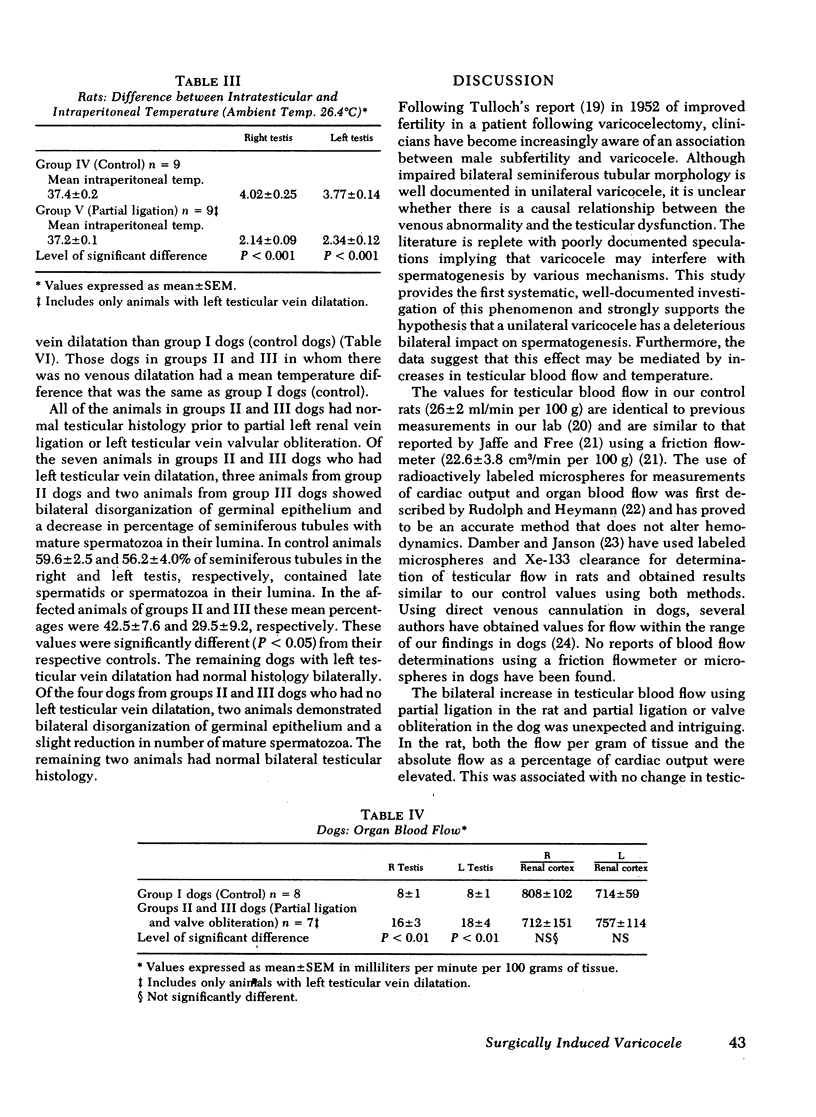
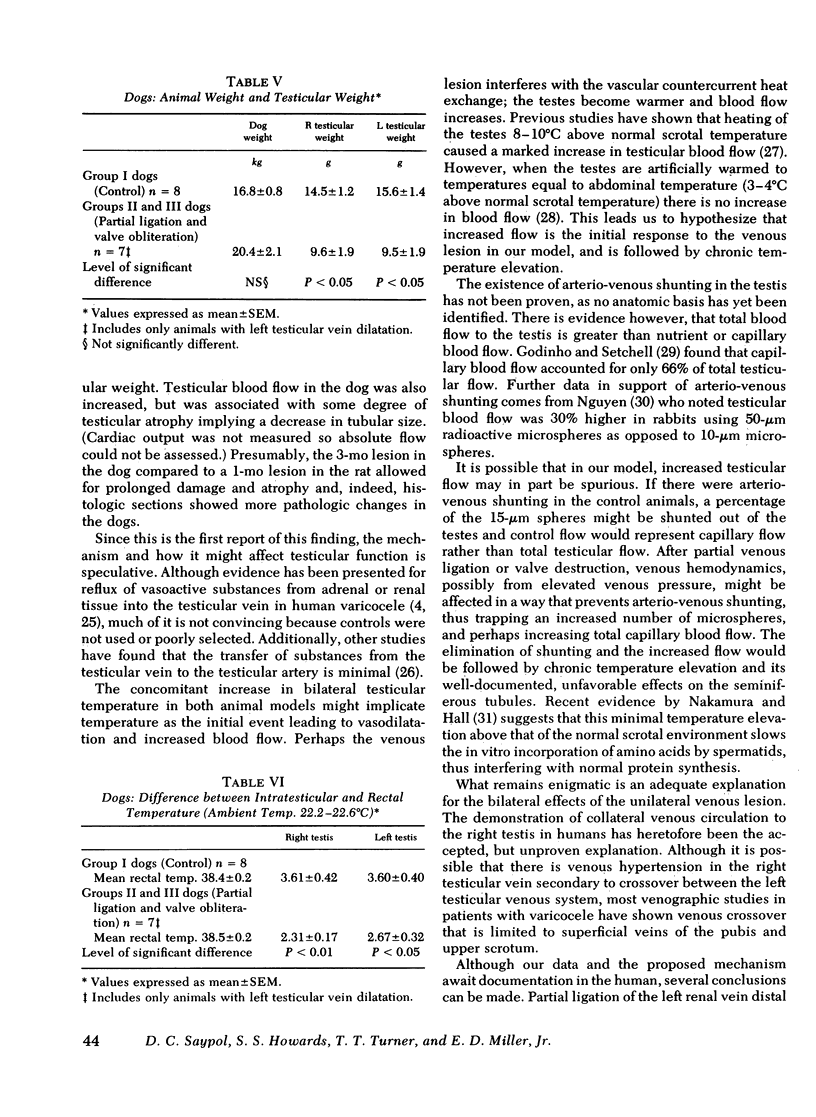

Images in this article
Selected References
These references are in PubMed. This may not be the complete list of references from this article.
- Agger P., Johnsen S. G. Quantitative evaluation of testicular biopsies in varicocele. Fertil Steril. 1978 Jan;29(1):52–57. doi: 10.1016/s0015-0282(16)43037-2. [DOI] [PubMed] [Google Scholar]
- Ahlberg N. E., Bartley O., Chidekel N., Fritjofsson A. Phlebography in varicocele scroti. Acta Radiol Diagn (Stockh) 1966 Sep;4(5):517–528. doi: 10.1177/028418516600400506. [DOI] [PubMed] [Google Scholar]
- Al-Juburi A., Pranikoff K., Dougherty K. A., Urry R. L., Cockett A. T. Alteration of semen quality in dogs after creation of varicocele. Urology. 1979 May;13(5):535–539. doi: 10.1016/0090-4295(79)90466-7. [DOI] [PubMed] [Google Scholar]
- Caldamone A. A., Al-Juburi A., Cockett A. T. The varicocele: elevated serotonin and infertility. J Urol. 1980 May;123(5):683–685. doi: 10.1016/s0022-5347(17)56091-7. [DOI] [PubMed] [Google Scholar]
- Charny C. W., Baum S. Varicocele and infertility. JAMA. 1968 Jun 24;204(13):1165–1168. [PubMed] [Google Scholar]
- Comhaire F., Vermeulen A. Plasma testosterone in patients with varicocele and sexual inadequacy. J Clin Endocrinol Metab. 1975 May;40(5):824–829. doi: 10.1210/jcem-40-5-824. [DOI] [PubMed] [Google Scholar]
- Comhaire F., Vermeulen A. Varicocele sterility: cortisol and catecholamines. Fertil Steril. 1974 Jan;25(1):88–95. doi: 10.1016/s0015-0282(16)40159-7. [DOI] [PubMed] [Google Scholar]
- Damber J. E., Janson P. O. Methodological aspects of testicular blood flow measurements in rats. Acta Physiol Scand. 1977 Nov;101(3):278–285. doi: 10.1111/j.1748-1716.1977.tb06009.x. [DOI] [PubMed] [Google Scholar]
- Donohue R. E., Brown J. S. Blood gases and pH determinations in the internal spermatic veins of subfertile men with varicocele. Fertil Steril. 1969 Mar-Apr;20(2):365–369. doi: 10.1016/s0015-0282(16)36979-5. [DOI] [PubMed] [Google Scholar]
- Dubin L., Amelar R. D. Etiologic factors in 1294 consecutive cases of male infertility. Fertil Steril. 1971 Aug;22(8):469–474. doi: 10.1016/s0015-0282(16)38400-x. [DOI] [PubMed] [Google Scholar]
- Glover T. D. Male infertility. The influence of temperature of flow of blood in the testis and scrotum of rats. Proc R Soc Med. 1966 Aug;59(8):765–766. [PMC free article] [PubMed] [Google Scholar]
- Godinho H. P., Setchell B. P. Proceedings: Total and capillary blood flow through the testes of anaesthetized rams. J Physiol. 1975 Sep;251(1):19P–20P. [PubMed] [Google Scholar]
- Jacks F., Setchell B. P. A technique for studying the transfer of substances from venous to arterial blood in the spermatic cord of wallabies and rams. J Physiol. 1973 Aug;233(1):17P–18P. [PubMed] [Google Scholar]
- Jaffe R. A., Free M. J. A miniature friction flowmeter for use in rat testicular artery and other small vessels. J Appl Physiol. 1972 Apr;32(4):571–573. doi: 10.1152/jappl.1972.32.4.571. [DOI] [PubMed] [Google Scholar]
- Kay R., Alexander N. J., Baugham W. L. Induced varicoceles in rhesus monkeys. Fertil Steril. 1979 Feb;31(2):195–199. [PubMed] [Google Scholar]
- MacLeod J. Seminal cytology in the presence of varicocele. Fertil Steril. 1965 Nov-Dec;16(6):735–757. doi: 10.1016/s0015-0282(16)35765-x. [DOI] [PubMed] [Google Scholar]
- Mobley D. F. Left spermatic vein cortisol in subfertile men with varicocele. Urology. 1974 Apr;3(4):461–464. doi: 10.1016/s0090-4295(74)80164-0. [DOI] [PubMed] [Google Scholar]
- Nakamura M., Hall P. F. The mechanism by which body temperature inhibits protein biosynthesis in spermatids of rat testes. J Biol Chem. 1980 Apr 10;255(7):2907–2913. [PubMed] [Google Scholar]
- Netto N. R., Jr, Lemos G. C., De Góes G. M. Varicocele: relation between anoxia and hypospermatogenesis. Int J Fertil. 1977;22(3):174–178. [PubMed] [Google Scholar]
- Rudolph A. M., Heymann M. A. The circulation of the fetus in utero. Methods for studying distribution of blood flow, cardiac output and organ blood flow. Circ Res. 1967 Aug;21(2):163–184. doi: 10.1161/01.res.21.2.163. [DOI] [PubMed] [Google Scholar]
- Shafik A., Bedeir G. A. Venous tension patterns in cord veins. I. In normal and varicocele individuals. J Urol. 1980 Mar;123(3):383–385. doi: 10.1016/s0022-5347(17)55945-5. [DOI] [PubMed] [Google Scholar]
- Swerdloff R. S., Walsh P. C. Pituitary and gonadal hormones in patients with varicocele. Fertil Steril. 1975 Oct;26(10):1006–1012. doi: 10.1016/s0015-0282(16)41416-0. [DOI] [PubMed] [Google Scholar]
- Tessler A. N., Krahn H. P. Varicocele and testicular temperature. Fertil Steril. 1966 Mar-Apr;17(2):201–203. doi: 10.1016/s0015-0282(16)35885-x. [DOI] [PubMed] [Google Scholar]
- Waites G. M., Setchell B. P., Quinlan D. Effect of local heating of the scrotum, testes and epididymides of rats on cardiac output and regional blood flow. J Reprod Fertil. 1973 Jul;34(1):41–49. doi: 10.1530/jrf.0.0340041. [DOI] [PubMed] [Google Scholar]
- Zerhouni E. A., Siegelman S. S., Walsh P. C., White R. I. Elevated pressure in the left renal vein in patients with varicocele: preliminary observations. J Urol. 1980 Apr;123(4):512–513. doi: 10.1016/s0022-5347(17)55996-0. [DOI] [PubMed] [Google Scholar]
- Zorgniotti A. W., Macleod J. Studies in temperature, human semen quality, and varicocele. Fertil Steril. 1973 Nov;24(11):854–863. [PubMed] [Google Scholar]



